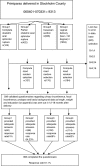A questionnaire on pelvic floor dysfunction postpartum
- PMID: 20798924
- PMCID: PMC3018591
- DOI: 10.1007/s00192-010-1243-9
A questionnaire on pelvic floor dysfunction postpartum
Abstract
Introduction and hypothesis: the incidence of obstetric anal sphincter injuries is used in Sweden as a measurement of quality of care and this might influence the reporting. However, the correlation between reported diagnosis of pelvic floor injury at delivery and pelvic floor symptoms a year later is unknown. A questionnaire could identify such symptoms and provide beneficial feedback to obstetrical practices.
Methods: we made a cross-sectional study by sending out a questionnaire about pelvic floor dysfunction to 599 women depending on reported injury at delivery. The answers provided by the groups were then compared.
Results: the questionnaire identified women with pelvic floor dysfunction. Anal incontinence was most common among women with obstetric anal sphincter injuries but also occurred among women delivered vaginally without known tears.
Conclusion: we suggest that a questionnaire is used 12-18 months after delivery to establish the short-time outcome in terms of pelvic floor dysfunction.
Figures
Similar articles
-
Factors Associated With Timing of Return to Intercourse After Obstetric Anal Sphincter Injuries.J Sex Med. 2016 Oct;13(10):1523-9. doi: 10.1016/j.jsxm.2016.07.010. Epub 2016 Aug 3. J Sex Med. 2016. PMID: 27497647
-
Pelvic Floor Disorders After Obstetric Avulsion of the Levator Ani Muscle.Female Pelvic Med Reconstr Surg. 2019 Jan/Feb;25(1):3-7. doi: 10.1097/SPV.0000000000000644. Female Pelvic Med Reconstr Surg. 2019. PMID: 30285979
-
Cross-sectional study of early postpartum pelvic floor dysfunction and related bother in primiparous women 6-10 weeks postpartum.Int Urogynecol J. 2021 Jul;32(7):1847-1855. doi: 10.1007/s00192-021-04813-y. Epub 2021 May 3. Int Urogynecol J. 2021. PMID: 33938963
-
[Postpartum pelvic floor muscle training and abdominal rehabilitation: Guidelines].J Gynecol Obstet Biol Reprod (Paris). 2015 Dec;44(10):1141-6. doi: 10.1016/j.jgyn.2015.09.023. Epub 2015 Oct 31. J Gynecol Obstet Biol Reprod (Paris). 2015. PMID: 26530172 Review. French.
-
[Pelvic floor and pregnancy].Gynecol Obstet Fertil. 2010 May;38(5):332-46. doi: 10.1016/j.gyobfe.2010.03.008. Epub 2010 Apr 24. Gynecol Obstet Fertil. 2010. PMID: 20456995 Review. French.
Cited by
-
Observation of the effect of physical rehabilitation therapy combined with the medication on pelvic floor dysfunction.Exp Ther Med. 2018 Feb;15(2):1211-1216. doi: 10.3892/etm.2017.5583. Epub 2017 Nov 29. Exp Ther Med. 2018. PMID: 29399117 Free PMC article.
-
Bothersome Pelvic Floor Dysfunction and Quality of Life During Pregnancy and Postpartum in Primiparous Women.Int Urogynecol J. 2025 Mar;36(3):635-646. doi: 10.1007/s00192-024-06038-1. Epub 2025 Jan 20. Int Urogynecol J. 2025. PMID: 39833538 Free PMC article.
-
Development and initial validation of a Swedish inventory to screen for symptoms of deficient perineum in women after vaginal childbirth: 'Karolinska Symptoms After Perineal Tear Inventory'.BMC Pregnancy Childbirth. 2022 Aug 13;22(1):638. doi: 10.1186/s12884-022-04964-w. BMC Pregnancy Childbirth. 2022. PMID: 35964017 Free PMC article.
-
Risk factors for perineal and vaginal tears in primiparous women - the prospective POPRACT-cohort study.BMC Pregnancy Childbirth. 2020 Dec 2;20(1):749. doi: 10.1186/s12884-020-03447-0. BMC Pregnancy Childbirth. 2020. PMID: 33267813 Free PMC article.
-
Levator Ani Deficiency and Pelvic Floor Dysfunction 1 Year Postpartum: A Prospective Nested Case-Control Study.BJOG. 2025 Apr;132(5):596-605. doi: 10.1111/1471-0528.18036. Epub 2024 Dec 3. BJOG. 2025. PMID: 39623952 Free PMC article.
References
Publication types
MeSH terms
LinkOut - more resources
Full Text Sources
Medical


